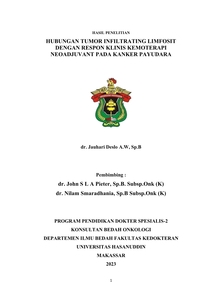Angkasa Wijaya, Jauhari Deslo (2024) HUBUNGAN TUMOR INFILTRATING LIMFOSIT DENGAN RESPON KLINIS KEMOTERAPI NEOADJUVAN PADA KANKER PAYUDARA. Disertasi thesis, Universitas Hasanuddin.
![[thumbnail of C028211002_tesis_20-08-2024 cover1.jpg]](/38961/1.hassmallThumbnailVersion/C028211002_tesis_20-08-2024%20cover1.jpg)

C028211002_tesis_20-08-2024 cover1.jpg
Download (303kB) | Preview
C028211002_tesis_20-08-2024 bab I-II.pdf
Download (2MB)
C028211002_tesis_20-08-2024 dp.pdf
Download (128kB)
C028211002_tesis_20-08-2024.pdf
Restricted to Repository staff only until 1 January 2027.
Download (2MB)
Abstract (Abstrak)
Relationship Between Tumor-Infiltrating Lymphocytes and Neoadjuvant Chemoterapy Responsiveness: A Cross-Sectional Study on Breast Cancer Patients
Abstract
Background: Tumor-infiltrating lymphocytes (TIL) are mononuclear cells found in tumor tissue that show an innate and adaptive immune response to tumor cells. T-reg lymphocytes effectively suppress the anti-tumor response of Tc lymphocytes and other immune cells, thereby facilitating tumor development. Anthracycline-based chemotherapy is a very important regimen and is most widely used in neoadjuvant and adjuvant KPD chemotherapy. The combination of anthracyclines with taxanes and cyclophosphamide (TAC) is quite widely used, with efficacy reaching 78%. This study aims to determine the relationship between tumor-infiltrating lymphocytes and the response to neoadjuvant chemotherapy in breast cancer.
Methods: This is a study of observational use. Retrospective cross-sectional design at Dr. Wahidin Sudirohusodo. A sample examination using the hematoxilin-eosin staining method was carried out in an accredited anatomical pathology laboratory from April 1 to September 30, 2023, obtaining 40 respondents. Samples were taken from tumor tissue in women who were diagnosed with KPD (clinical and histopathological examination), with the inclusion criteria being KPD women who had been diagnosed with anatomical pathology and KPD women who had received neoadjuvant chemotherapy and were willing to take part in this study.
Results: Of the 40 participants, the average sample age was 40 (27–73 years), clinical stage III (40.0%), had moderate TIL concentrations (47.5%), and was responsive to neoadjuvant chemotherapy (87.5%). There was no significant relationship between TIL concentration and chemotherapy response (p > 0.05). However, after chemotherapy, the tumor size value in the high TIL group showed a p value (p = 0.034), indicating a significant relationship between TIL and tumor size.
Conclusion: This study shows that there is no significant relationship between TIL and clinical response to neoadjuvant chemotherapy; however, high TIL after chemotherapy has a tendency for clinical tumor size to decrease. Further research is needed on TIL and the response to neoadjuvant chemotherapy in breast cancer, with a greater number of research variables.
Key words: breast neoplasms, cross-sectional studies, neoadjuvant therapy, lymphocytes, tumor-infiltrating
| Item Type: | Thesis (Disertasi) |
|---|---|
| Uncontrolled Keywords: | Key words: breast neoplasms, cross-sectional studies, neoadjuvant therapy, lymphocytes, tumor-infiltrating |
| Subjects: | R Medicine > RD Surgery |
| Divisions (Program Studi): | Fakultas Kedokteran > PPDS Ilmu Bedah |
| Depositing User: | Kamaluddin Mantasa |
| Date Deposited: | 05 Nov 2024 00:19 |
| Last Modified: | 05 Nov 2024 00:19 |
| URI: | http://repository.unhas.ac.id:443/id/eprint/38961 |


